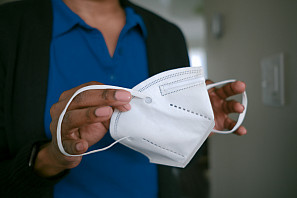3 tips for spotting a fake N95 or KN95
By Amanda Roach
January 18, 2022

With the guidance from public health experts that we should all be wearing better masks in light of the current surge in COVID-19 cases, many people are ditching their early-pandemic cloth masks for more effective styles. Experts note that the most effective masks on the market right now are N95s and KN95s.
The problem: The Centers for Disease Control and Prevention reports that around 60 percent of KN95s in the U.S. are counterfeit and do not meet the National Institute for Occupational Safety and Health standards.
We talked to Kathryn Manteuffel, university director for Environmental Health and Safety, to get her tips for spotting a fake and making sure your N95 or KN95 mask is legit.
Tip 1: Do your homework
The CDC has one of the most comprehensive resources for researching masks that follow international standards like KN95 masks. The National Personal Protective Technology Laboratory performed assessments on a wide variety of masks through December 2021. You can sort by brand name and specific mask model. Pay particular attention to the filter efficiency column. You want this to be 95 percent or greater.
The CDC also maintains a listing of all NIOSH-approved N95 masks and updates it weekly. If a mask has made this list, it’s passed the NIOSH standards and filters at least 95 percent of airborne particles.
Tip 2: Buy from a reputable seller
In addition to researching your mask, you should research where you’re purchasing the mask from. Don’t just click the first result you find and assume it’s reputable. Sites like projectN95.org and bonafidemasks.com are good places to start for purchasing masks. In addition to the above CDC list, The New York Times also shared its research on a number of N95, KN95 and surgical masks.
Tip 3: Know what you’re looking for
Depending on the type of mask you want to purchase, there are some key visible characteristics that will help you identify the fakes.
Warning signals for KN95s include:
- Claims that it’s approved by the CDC or NIOSH (these organizations do not approve KN95s).
- Packaging does not include key elements like the manufacturer’s name; the “CE” logo, which means that the mask meets European regulations; type and model number, or business license number.
- Missing a package insert with instructions, intended use, etc.
- Claims that it is effective for prevention of COVID-19 (printed materials cannot represent, claim or suggest they prevent COVID-19).
- Does not have the CE logo on the mask itself.
For N95s, some red flags to look for include:
- No markings on the mask.
- No approval (TC) number on mask.
- No NIOSH markings.
- NIOSH spelled incorrectly.
- Decorative fabric or decorative add-ons such as sequins.
- Claims that they’re approved for use in children (NIOSH does not approve any masks for children).
- Ear loops instead of headbands.
The bottom line
Do your research, be patient with companies and shipping times given increased demand, and wear the best mask possible, especially when indoors. While you’re waiting for the ever-popular “your order is out for delivery” notification for your new N95s or KN95s, you can also double mask by layering a good cloth mask over a surgical mask.
Looking for info on how to reuse a KN95 or N95? Learn how here.
Amanda Roach is a senior communications consultant with the Office of the Vice President for Communications and Marketing.